 The latest issue of Art Calendar (newsstand edition) has a series of great articles on building and maintaining your online art presence. There’s sections on Social Networking, promoting art in “Second Life” (an online 3-D virtual world), Website Design, and Search Engine Optimization. Go get a copy – We think Art Calendar is a fantastic resource for all emerging and mid-career artists.
The latest issue of Art Calendar (newsstand edition) has a series of great articles on building and maintaining your online art presence. There’s sections on Social Networking, promoting art in “Second Life” (an online 3-D virtual world), Website Design, and Search Engine Optimization. Go get a copy – We think Art Calendar is a fantastic resource for all emerging and mid-career artists.
Two articles particularly dear to our design hearts are “How to Work with a Professional Website Designer” and “Design Tips for Artist Websites” in which Gay Jervey gives some excellent tips on achieving successful results with high-quality art websites. At our sister site, “Beautiful Artist websites” It has long been our contention that the single most important factor in an artist website is excellent showcasing. Artists need to be careful of some of the self-design and inexpensive portfolio solutions because in many cases the work just doesn’t showcase well.
Take a good look at your website and ask yourself honesty – does the work look compelling enough to evoke serious interest from a buyer?? If not, you need to decide on a new online strategy.
While we love Gay’s articles we do have a few points of disagreement, having designed a lot of artist websites in the last few years. Let me make those points here:
Color Schemes: It is true that for most websites placing light-color text on a dark background is a mistake because it becomes just too hard to read. This is particularly true in news sites with large amounts of text content. An artist’s website is different though – in many cases the text content is quite small and the quality of art showcasing given by a dark background overshadows this requirement. As examples take a look at Rick Clarence Art and Decor-American Fine Art.
Self Maintaining: Most artists want to be able to maintain their websites themselves for obvious reasons. However there are drawbacks to this – the most important one being that sometimes the updates (especially images) don’t look as good as when they are made by a professional designer. There is an alternative to self-maintaining – talk with your designer about a simple maintenance plan with a flat-rate price per image and price per text page change.
Hosting: Gay’s article suggests that it’s very important that the artist manages their own website hosting. Our Perspective: After designing many art websites with different technical hosting requirements we actually require our clients to host with us. Why? Not for profit – but simply that we can guarantee the performance of our sites. With anything beyond a very simple website (especially Content Management Systems) we need to have a controlled software environment where we know exactly what hosting software versions are in use and variations in their implementation. We also need to have excellent support relationships with the hosting company so that we know when potentially performance-affecting changes are being planned or made. Bottom line – at least be willing to host your website with a company that your designer recommends. Don’t just insist on the cheapest solution you can find – you may regret it.
Thanks for a great issue Art Calendar!



Thanks for sharing this info post.